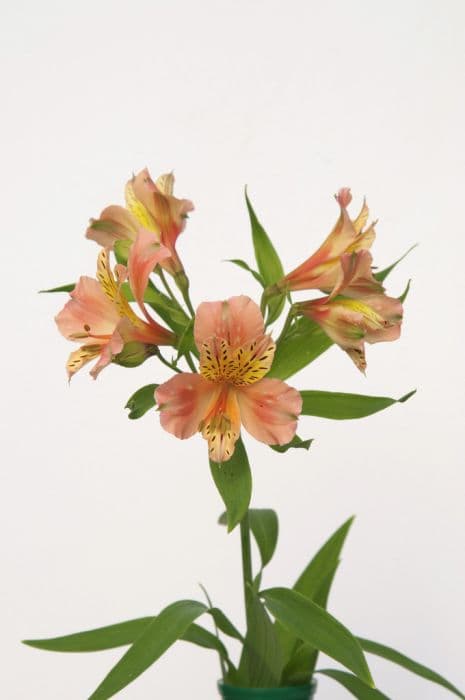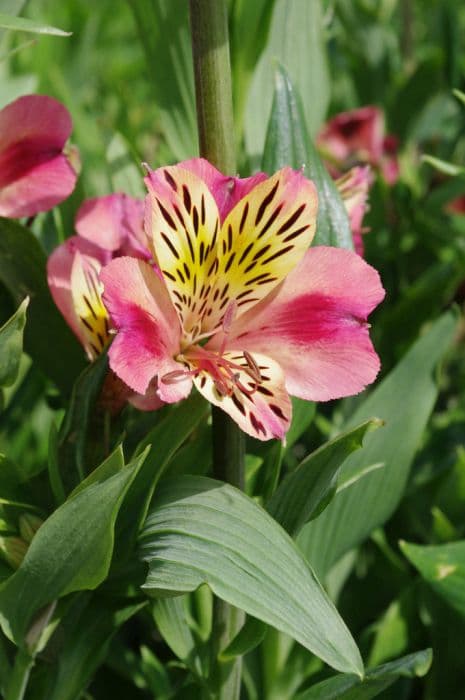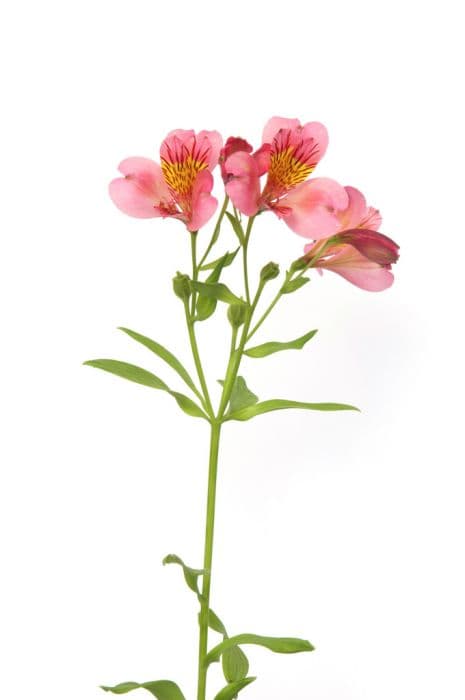Peruvian Lily Alstroemeria 'Maestro' (PBR)

ABOUT
Alstroemeria 'Maestro' is an ornamental plant commonly known as Peruvian lily or lily of the Incas. This vibrant plant is characterized by its showy, funnel-shaped flowers which display a striking combination of colors. The blossoms usually have a base color of soft pink, with darker pink flushes and streaks, alongside some burgundy speckles. Each flower consists of numerous petals, which are often slightly ruffled at the edges, adding to their appeal. The blooms are clustered at the top of tall, upright stems which are adorned with lance-shaped leaves. These leaves have a distinctive twist so that the bottom side faces up. The foliage is typically a rich green, providing a lush backdrop for the eye-catching flowers. Alstroemeria 'Maestro' generally has a bushy and compact growth habit, with its numerous stems creating a dense and full appearance. During its blooming period, the Peruvian lily becomes a focal point in any garden setting due to its vivid colors and exotic look. This perennial is not only sought after for its beauty in gardens but also as a long-lasting cut flower, making it a popular choice for floral arrangements. The contrast between the colorful flowers and the green foliage, along with the plant's floriferous nature, makes Alstroemeria 'Maestro' a truly captivating specimen in any display.
About this plant
 Names
NamesFamily
Alstroemeriaceae
Synonyms
Peruvian Lily, Lily of the Incas, Parrot Lily
Common names
Alstroemeria 'Maestro' (PBR).
 Toxicity
ToxicityTo humans
The Peruvian Lily, as Alstroemeria 'Maestro' is commonly known, is not considered highly toxic to humans. However, they can cause mild irritation to the skin upon contact for some people due to the presence of tuliposides, which are natural compounds found in these plants. If ingested, parts of the Peruvian Lily may cause minor gastrointestinal discomfort, such as nausea or vomiting, although severe poisoning is rare. It is generally advised to avoid ingesting any part of ornamental plants as a precaution.
To pets
The Peruvian Lily is known to have a low level of toxicity for pets such as cats and dogs. If a pet ingests part of the Peruvian Lily, it might experience mild gastrointestinal upset, including symptoms like vomiting or diarrhea. As with humans, severe poisoning is not common, but it is still advisable to prevent pets from ingesting the plant and to consult a veterinarian if ingestion does occur and symptoms arise.
 Characteristics
CharacteristicsLife cycle
Perennials
Foliage type
Deciduous
Color of leaves
Green
Flower color
Mixed
Height
2-3 feet (60-90 cm)
Spread
2 feet (60 cm)
Plant type
Herb
Hardiness zones
7
Native area
South America
Benefits
 General Benefits
General Benefits- Long-lasting Blooms: Alstroemeria 'Maestro' produces vibrant flowers that can last up to two weeks in a vase, making it ideal for floral arrangements.
- Attracts Pollinators: The trumpet-shaped flowers draw in bees, butterflies, and hummingbirds, supporting local ecosystems.
- Drought Tolerance: Once established, the plant can tolerate periods of low water, making it suitable for xeriscaping and reducing the need for frequent watering.
- Seasonal Interest: It offers a pop of color in gardens from late spring through fall, enhancing the garden's visual appeal across multiple seasons.
- Versatile Use: Suitable for borders, containers, and as a cut flower, Alstroemeria 'Maestro' is versatile in its use in landscaping and home decor.
- Low Maintenance: The plant requires minimal upkeep beyond occasional watering and deadheading to promote further blooming.
- Rapid Growth: It can grow quickly to fill in spaces in the garden, making it an ideal plant for establishing coverage and reducing weed growth.
 Medical Properties
Medical PropertiesThis plant is not used for medical purposes.
 Air-purifying Qualities
Air-purifying QualitiesThis plant is not specifically known for air purifying qualities.
 Other Uses
Other Uses- The Alstroemeria, also known as Peruvian Lily, can be used as a natural dye source, with its flowers providing hues for textiles and art projects.
- Peruvian Lilies can be pressed and included in personal stationery or greeting cards, adding a personal touch with their bright colors.
- They can serve as a teaching tool in horticulture classes, demonstrating plant breeding and hybridization techniques.
- Peruvian Lilies can act as an indicator of climate change, as changes in flowering patterns can reflect environmental shifts.
- They can be used in photography as a popular subject for botanical prints and close-up photography, showcasing the intricate patterns and vibrant colors.
- These plants can be part of a sensory garden for the visually impaired, offering a variety of textures from their flower petals and leaves.
- Peruvian Lilies' stems can be woven into baskets or other crafts, utilizing their flexibility when green.
- The blossoms of these plants can be frozen in ice cubes for decorative, edible additions to summer beverages.
- Used in perfumery, the scent of Peruvian Lilies can be captured and used in creating floral fragrances.
- Their resilient nature makes them suitable candidates for use in research on sustainable flower production and agricultural practices.
Interesting Facts
 Feng Shui
Feng ShuiThe Peruvian Lily is not used in Feng Shui practice.
 Zodiac Sign Compitability
Zodiac Sign CompitabilityThe Peruvian Lily is not used in astrology practice.
 Plant Symbolism
Plant Symbolism- Friendship: Alstroemeria, commonly known as Peruvian Lily or Lily of the Incas, is often associated with deep bonds of friendship due to its intricate and intertwined petals, representing the intermingling of two lives.
- Devotion and Loyalty: The Peruvian Lily symbolizes a commitment to support loved ones, with its long-lasting blooms suggesting the endurance of relationships over time.
- Wealth and Prosperity: Its multiple flowers on each stem are thought to signify an abundance of gifts, echoing themes of wealth and prosperity.
- Achievement of Dreams: Because the Peruvian Lily blossoms in a variety of colors, it is often linked with the determination required to reach one's dreams and celebrate success.
- Mutual Support: The plant's ability to support other flowers in a bouquet has led to its association with mutual support in partnerships.
- Strength: The Peruvian Lily's robustness and ability to adapt to different environments is seen as a symbol of resilience and strength.
 Water
WaterPeruvian lilies should be watered deeply until the water runs out of the drainage holes, and the soil should be kept moist but not waterlogged. During the growing season, water the plant approximately once a week, providing about 1 to 2 gallons of water each time, depending on the size of the plant and the pot. Reduce watering frequency in the winter, when the plant is not actively growing, to prevent root rot. Ensure the top inch of the soil is dry before watering again to encourage deep root growth and avoid overwatering.
 Light
LightPeruvian lilies thrive in a location that offers full sun to partial shade. The ideal spot would receive direct sunlight for at least 6 hours a day, but some afternoon shade can be beneficial in very hot climates. Avoid placing the plant in deep shade, as this can reduce blooming and weaken the plant.
 Temperature
TemperaturePeruvian lilies prefer moderate temperatures and can generally tolerate conditions between 35°F and 80°F. The ideal temperature range for the plant is 65°F to 75°F during the day and slightly cooler at night. Extreme cold or heat can damage the plant, so it should be protected from frost and not subjected to extreme heat for prolonged periods.
 Pruning
PruningPeruvian lilies require pruning to remove spent flowers and encourage further blooming. Cut the stems off at the base after the blooms have faded, which can be done every few weeks during the blooming season. The best time to perform a larger pruning and reshape the plant is in the late winter or early spring before new growth begins.
 Cleaning
CleaningAs needed
 Soil
SoilThe Peruvian Lily prefers well-draining soil, a mixture of loam, sand, and peat, with a pH of around 6 to 7.
 Repotting
RepottingPeruvian Lilies should be repotted every 2 to 3 years to refresh the soil and accommodate growth.
 Humidity & Misting
Humidity & MistingPeruvian Lily thrives best at moderate humidity levels, around 40-60%.
 Suitable locations
Suitable locationsIndoor
Place in bright, indirect light and keep soil moist.
Outdoor
Plant in partial shade, shelter from wind, amend soil well.
Hardiness zone
7-10 USDA.
 Life cycle
Life cycleThe Alstroemeria 'Maestro' (PBR), commonly known as Peruvian Lily or Lily of the Incas, begins its life cycle as a rhizome, which is a type of underground stem that can produce the roots and shoots necessary for the plant to grow. Once planted, the rhizome sprouts and develops into a flowering plant with sturdy stems and lance-shaped leaves. The plant enters a phase of vegetative growth where it focuses on leaf production to gather sunlight and strengthen its stems. Following vegetative growth, the Peruvian Lily will produce clusters of funnel-shaped, brightly colored flowers, often marked with contrasting streaks or spots, which attract pollinators. After pollination, the plant forms seed capsules, and once these seed capsules dry, they release the seeds, which can be dispersed to form new plants. In addition to seed production, the Alstroemeria 'Maestro' (PBR) can also propagate vegetatively through the division of its rhizomes, enabling the growth of genetically identical plants.
 Propogation
PropogationPropogation time
Spring to Summer
Alstroemeria 'Maestro', commonly known as Peruvian Lily or Lily of the Incas, is frequently propagated by division, which is the most popular method. The best time to propagate by division is in early spring or fall when the plant is not actively blooming. To propagate, carefully lift the clump of tubers from the ground, ensuring minimal damage. Using a sharp knife or spade, divide the clump into smaller sections, making sure each section has at least one or two growth points or shoots. Replant the divisions at the same depth they were growing at previously, which is usually about 6 to 8 inches (15 to 20 centimeters) deep, and water them in well. These divisions should be spaced about 12 to 18 inches (30 to 45 centimeters) apart to allow for adequate room for growth. This method allows for the rapid increase of plants and helps maintain the health of the clumps by decreasing overcrowding.




![Peruvian lily [H.R.H. Princess Alice]](/_next/image?url=https%3A%2F%2Fplants-admin.emdemapps.com%2Fimages%2Fplants%2F%2Fimages%2F604b55e81c8b0.png&w=640&q=75)
![Peruvian lily [Indian summer]](/_next/image?url=https%3A%2F%2Fplants-admin.emdemapps.com%2Fimages%2Fplants%2F%2Fimages%2F604b616bc746b.png&w=640&q=75)
![Peruvian lily [Inticancha Creamy Dark Pink]](/_next/image?url=https%3A%2F%2Fplants-admin.emdemapps.com%2Fimages%2Fplants%2F%2Fimages%2F604b5e98bea7c.png&w=640&q=75)
![Peruvian lily [Inticancha Imala]](/_next/image?url=https%3A%2F%2Fplants-admin.emdemapps.com%2Fimages%2Fplants%2F%2Fimages%2F604b619b522ba.png&w=640&q=75)
![Peruvian lily [Inticancha Red]](/_next/image?url=https%3A%2F%2Fplants-admin.emdemapps.com%2Fimages%2Fplants%2F%2Fimages%2F604b5aebac273.png&w=640&q=75)
![Peruvian lily [Inticancha Sunday]](/_next/image?url=https%3A%2F%2Fplants-admin.emdemapps.com%2Fimages%2Fplants%2F%2Fimages%2F604b646146dd9.png&w=640&q=75)